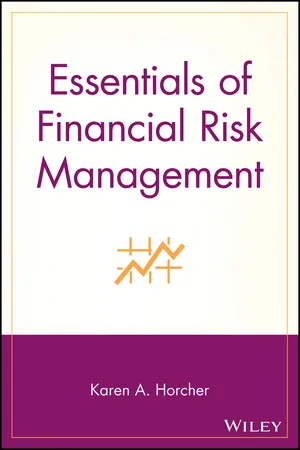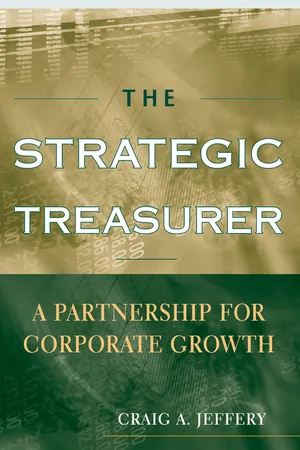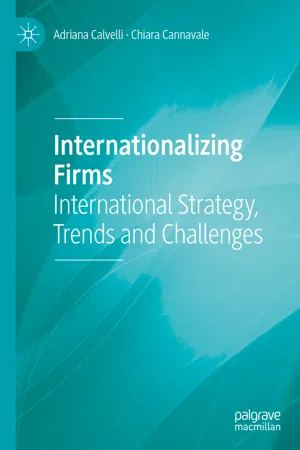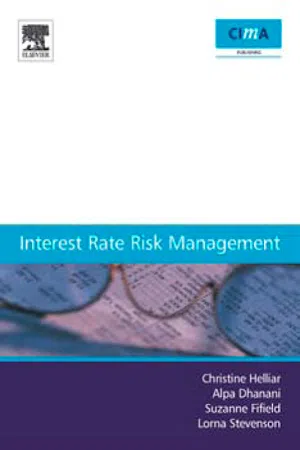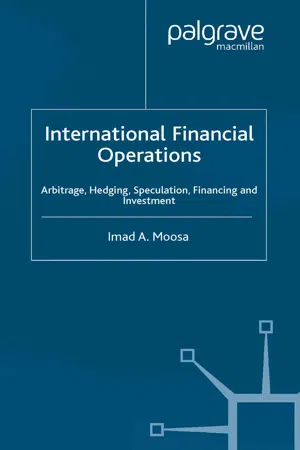Business
Risk of Hedging
The risk of hedging refers to the potential for financial loss or ineffectiveness when using hedging strategies to mitigate risks such as currency fluctuations or commodity price changes. While hedging can protect against adverse market movements, it also carries the risk of incurring costs or missing out on potential gains if the hedging strategy does not align with market conditions.
Written by Perlego with AI-assistance
Related key terms
1 of 5
7 Key excerpts on "Risk of Hedging"
- eBook - ePub
- Karen A. Horcher(Author)
- 2011(Publication Date)
- Wiley(Publisher)
Risks are events and described as high or low probability. If an event occurs, it has the potential for losses that range in size from small to large. Often, one measure is high and the other is low—for example, a high probability of a small loss. This type of loss might be represented by routine exchange rate fluctuations.The most dangerous risks are those with a low probability of occurring but the potential for a large loss. Sometimes known as icebergs, these risks appear suddenly and can result in large losses. The failure of a counterparty and the resultant loss could be an example of such a risk.Once an acceptable level of exposure has been established, management can determine how to reduce the potential for loss to an acceptable level. Competitive LandscapeAn important consideration in making hedging decisions is the expected activity of competitors. If an organization hedges and its major competitors do not, the organization may be at a disadvantage if market rates or prices move favorably. The reverse is also true. If the organization hedges and exchange rates move adversely, the organization may have an advantage over its competitors.Changes to an organization’s pricing structure, as a result of changing costs, may cause customers to buy or consume more or less. Financial risk can sometimes be passed on to customers or end users in the form of price adjustments, reducing the impact to the organization. This is most often possible when demand is inflexible or slow to react to price changes.The activities of competitors and the market affect the competitive landscape in the following ways:- Propensity of customers to accept risk through rising prices
- Willingness of vendors to offer fixed-price contracts or dual-currency pricing
- How products are priced
- Where product inputs, including commodity components, are sourced
- Alternative inputs to products and sources of inputs
- Commodity components
Management typically develops risk management policy, while the board of directors has responsibility for its approval. As representatives of shareholders, the board’s responsibilities include oversight of management. Given the potential for substantial losses, boards are especially concerned about financial risk management and its implications in these key areas: - eBook - ePub
The Strategic Treasurer
A Partnership for Corporate Growth
- Craig A. Jeffery(Author)
- 2009(Publication Date)
- Wiley(Publisher)
In a highly competitive price environment in which a firm may have little control over setting prices, passing cost variability through to customers—in the form of price increases or a surcharge—may not be practicable. On the other hand, pressuring a vendor to absorb risk only transfers its cost. It is still a component cost that has to be managed. As such, one must consider who is better equipped or experienced to manage the risk at the optimal cost.Hedge the Risk
If all efforts to alter or reduce the risk to an acceptable level within the firm’s risk appetite either fail, are exhausted, or are cost prohibitive relative to the potential benefits, then the alternative may be to manage it through a hedging program or the purchase of insurance. The goal is the mitigation of risk, by bringing it within your organization’s risk tolerance, not necessarily eliminating the risk completely.The process of mitigating the risk is to acquire an offsetting exposure. This may be, for example, either a derivative instrument such as an option, future, or swap; a fixed purchase or sales contract for physical delivery; or an offsetting asset or liability in order to limit the uncertain impact to fair value or cash flow.Possible Reasons for HedgingReduce Volatility
Hedging is used to reduce the volatility in the firm’s cash flow, earnings, and/or fair value of investments. The goal is to reduce the variance in possible outcomes. The question may arise: Why reduce the volatility in, for example, cash flow? The primary reasons for hedging are to:1. Avoid financial distress. 2. Allow better predictability that enables management to plan.An effective hedging program narrows the distribution of probable outcomes (volatility) and, therefore, lowers the probability of financial distress and/or extraneous financial risks impacting results, all else being equal (see Exhibit 10.3 ).EXHIBIT 10.3 Hedging: Probability/OutcomeAvoid Financial Distress
Financial distress may be a short-term liquidity crunch that impedes an entity’s ability to satisfy its cash requirements; or it may be as severe as bankruptcy (worse-case threshold). Recall the premise of gamblers ruin - eBook - ePub
Internationalizing Firms
International Strategy, Trends and Challenges
- Adriana Calvelli, Chiara Cannavale(Authors)
- 2018(Publication Date)
- Palgrave Macmillan(Publisher)
portfolios .If the shareholders’ interest is not the main determinant leading the company to hedge against financial risks, the incentivizing factors are linked to the possibility that suitable hedging policies and the choice of appropriate hedging instruments can shelter the company from liquidity crisis, and from a strict dependency on contingent factors, thus helping it act with a long-term outlook, with positive effects on maintaining or growing its economic value . This is particularly important in the perspective of an environment subject to changes that not only cannot be controlled, but often cannot be foreseen. On the other hand, the greater environmental complexity has only increased the types of risks and their intensity.The multiple financial risks that companies operating internationally, both outgoing and incoming, have to face may be summed up as follows (Errunza and Losq 1987 ):- Currency risks, related to volatile exchange rates and to the loss of consumers’ purchasing power
- Political risks, including the risks of expropriation and nationalization, which present an explicit barrier to capital flows
- Investment risks, correlated with the stage of development achieved by the host country
Currency Risks
Currency risk, which is to say the risk connected with the variability of exchange rates, produces three important effects for companies:- 1. In the first place, an exchange variation impacts the debts owed to and by companies in foreign currency. This risk, defined as transaction risk, is manifested whenever companies grant or receive deferments of payment by or from counterparties situated in different countries. Of course, the risk exists only if the transaction must be settled in a currency other than the home currency, and yields its effects when calculating the countervalues in national currency of debts owed or to be collected in foreign currency. In a “direct or indirect” regime, it takes concrete form as follows: for the importer, the possibility that a reduction in the exchange might result in an increase in the euro countervalue of debts owed in foreign currency; for the exporter (seller), the possibility that an increase in the exchange might result in a decrease in the euro countervalue of the debt owed to it in foreign currency. To the contrary, in an “indirect or direct” regime, the importer fears the increase in the exchange rate (a circumstance that would increase the countervalue of the debt expressed in its own reporting currency), and the exporter fears the decline in the exchange rate (which would diminish the countervalue
- eBook - PDF
- Christine Helliar(Author)
- 2005(Publication Date)
- CIMA Publishing(Publisher)
This result arises from the convexity of the cor-porate tax structure (caused by progressive taxes and tax shields) and the fact that hedging reduces the variance of the firm’s taxable income. In particular, in the presence of a convex tax code, hedg-ing can be beneficial if it ensures that taxable income falls within the optimal range of tax rates. That is, risk management can lead to lower tax payments. These capital market imperfections of the neo-classical model of economic theory are now widely accepted, and it is recognised that companies employ specialised staff to conduct hedging operations (Helliar, 1997). This monograph accepts these postulates and assumes that corporate financial risk management is an important technique that is used by a wide variety of companies. 2.5 Interest rate and foreign exchange risk management Companies often face two key financial risk exposures; IRR and FX rate risk (Holland, 1993; Brigham and Gapenski, 1994; Buckley, 2000). IRR is concerned with the variability of profit, cash flows or the valuation of a company to movements in interest rates (Buckley, 2000). FX exposure arises because currency movements may affect the home currency values and potentially affect the firm’s competi-tiveness (Buckley, 2000). Buckley (2000) argues that FX exposure Interest Rate Risk Management 18 can be categorised into three different types of exposure: translation exposure, transaction exposure and economic exposure. Translation exposure reflects the gain or loss arising from the consolidation of financial statements, while transaction exposure arises from the settlement of a future payment or receipt denominated in a foreign currency, the amount of which will fluctuate due to changes in exchange rates. Finally, economic exposure relates to future corpor-ate strategy, where the objective is to enhance competitiveness by maximising economic value over the long term (Belk and Glaum, 1990; Moffet and Karlsen, 1994). - eBook - PDF
Risk Management Systems
Process, Technology and Trends
- M. Gorrod(Author)
- 2003(Publication Date)
- Palgrave Macmillan(Publisher)
Even where it is thought that the risks are well understood, the risk manager needs to be constantly looking for previously unidentified risks, or inherent assumptions and failings in the calculation and management of those risks. This is especially true when these risks may only become evident in extreme market conditions. If these risks are not identified and controlled, the organization is likely to suffer the same fate as that of Long Term Capital Management (LTCM), the US hedge fund that came close to financial collapse due to unexpected market events and behaviour in 1998. 1 Financial markets enable participants to raise capital and exchange risks, so that one participant’s risk becomes another’s potential reward or offsets a risk they already have. Market participants then structure and trade these risks so as to either remove (that is, hedge) or take on additional risk in return for a given benefit or expected return; this latter activity is known as speculating. Risk may also be retained or additional risk taken on if there is a belief that the market is mispricing the cost of taking on this risk. This activity is known as relative value or richness/cheapness analysis and can have varying levels of sophistication. The aim of this trading strategy is to try to benefit from any mispricing by buying or selling the instru- ments involved on the assumption that the market will correctly price them in the future (resulting in a greater than expected return). If these mispricings result in a transaction which leaves no residual risk but rather a guaranteed return or profit, then this is called arbitraging. Arbitraging can also cause (through variations in supply and demand resulting in changes in prices) the mispricings to disappear and so plays a vital role in the finan- cial markets in ensuring different financial instruments are fairly priced. - eBook - PDF
- Alan C. Shapiro, Paul Hanouna(Authors)
- 2019(Publication Date)
- Wiley(Publisher)
Hedge ineffectiveness can lead to earnings volatility. A foreign currency derivative that cannot be shown to be effective in hedging a specific foreign currency risk must be marked to market and any gain or loss on it included in current earnings, making reported earnings more volatile. 9.4.6 Empirical Evidence on Hedging The most important issue in hedging is whether it works. Here the evidence is mixed. According to a re- cent, large-scale study on hedging practices and their consequences, employing a sample of 6,888 firms headquartered in 47 different countries, the use of financial derivatives reduces the risk of companies that MANAGING TRANSLATION EXPOSURE 261 hedge compared to nonhedging companies. 8 This evidence suggests that despite the horror stories of compa- nies using derivatives to gamble, most firms use them to reduce risk. However, there is only weak evidence that hedging increases company value. One possible explanation for this result is that financial markets are correctly pricing risks and hence derivatives, leaving little if any value to be added through their purchase and use. 9.5 MANAGING TRANSLATION EXPOSURE Firms have three available methods for managing their translation exposure: (1) adjusting fund flows, (2) en- tering into forward contracts, and (3) exposure netting. The basic hedging strategy for reducing translation exposure shown in Table 9.6 uses these methods. Essentially, the strategy involves increasing hard currency (likely to appreciate) assets and decreasing soft currency (likely to depreciate) assets, while simultaneously decreasing hard currency liabilities and increasing soft currency liabilities. For example, if a devaluation ap- pears likely, the basic hedging strategy will be executed as follows: Reduce the level of cash, tighten credit terms to decrease accounts receivable, increase LC borrowing, delay accounts payable, and sell the weak currency forward. - eBook - PDF
International Financial Operations
Arbitrage, Hedging, Speculation, Financing and Investment
- I. Moosa(Author)
- 2003(Publication Date)
- Palgrave Macmillan(Publisher)
CHAPTER 4 Hedging Exposure to Foreign Exchange Risk: The Basic Concepts 4.1 DEFINITION AND MEASUREMENT OF FOREIGN EXCHANGE RISK Foreign exchange risk arises because of uncertainty about the exchange rate prevailing in the future (after a decision involving exchange rate expectations has been taken, such that the outcome depends on the materialisation or otherwise of the expectations). It refers to the variability of the base currency value of assets, liabilities and cash flows (contractual or otherwise) resulting from the variability of the exchange rate. Therefore foreign exchange risk arises when a firm indulges in international operations involving currencies other than the base currency, including importing, exporting, investing and financing. As a result, the firm will be exposed to assets, liabilities and cash flows denominated in currencies other than the base currency. We have to remember that foreign exchange risk is associated with unanticipated changes in exchange rates, since anticipated changes are discounted and reflected in the value of the firm. The concept of foreign exchange risk will be illustrated by referring to an investment decision. Assume that an investor with a base currency x takes up an investment in a y-denominated asset at time t, maturing at time t + 1. If V x and V y are the x and y values of the asset respectively, then V x = S(x/y)V y (4.1) In what follows, we will for simplicity drop (x/y) from the symbol representing the spot exchange rate, but it is crucial to bear in mind that the exchange rate in this analysis is measured as the x price of one unit of y. The rate of return on the asset between t and t + 1 in terms of x is given by 65 ( ) , , , , 1 1 1 1 + = = + + + R V V S V S V x t x t t y t t y t (4.2) or ( ) ( )( ) 1 1 1 + = + + R S V y (4.3) where S and V y are respectively the percentage changes in the exchange rate and the y-denominated value of the asset between t and t + 1.
Index pages curate the most relevant extracts from our library of academic textbooks. They’ve been created using an in-house natural language model (NLM), each adding context and meaning to key research topics.
